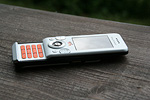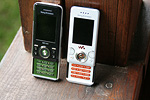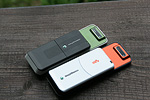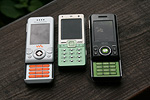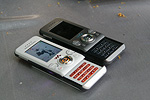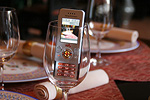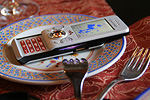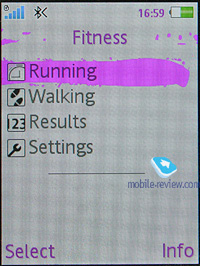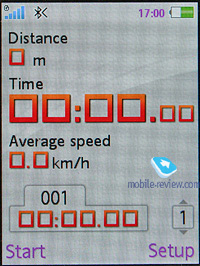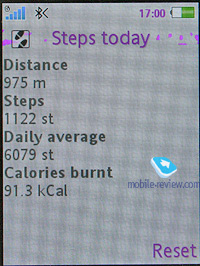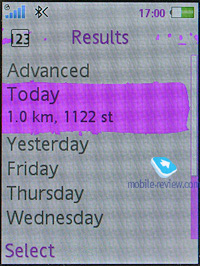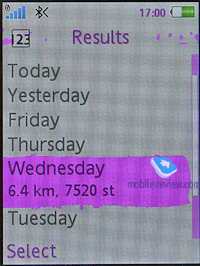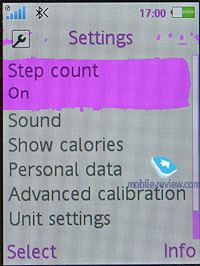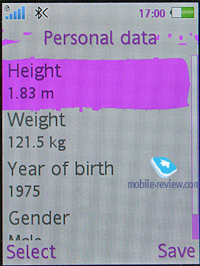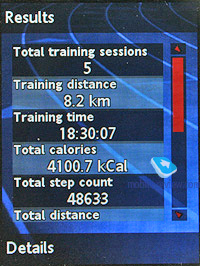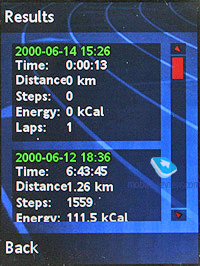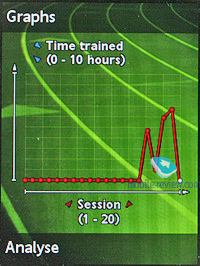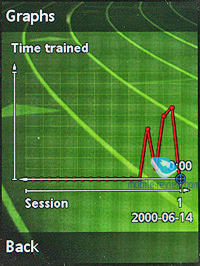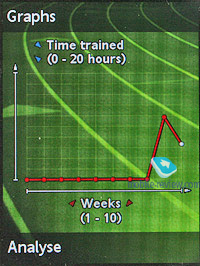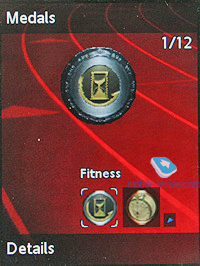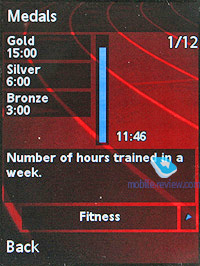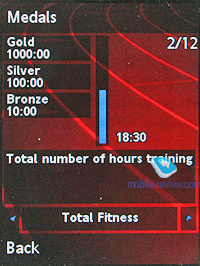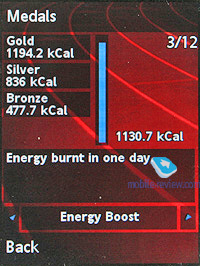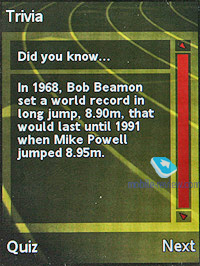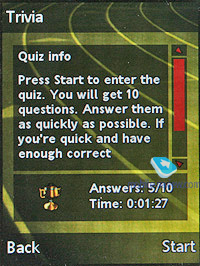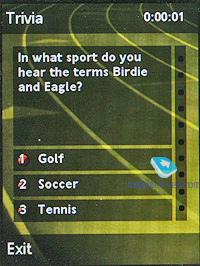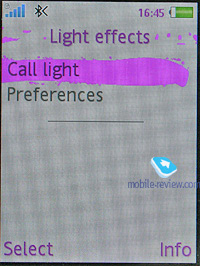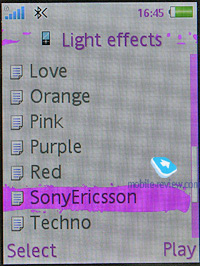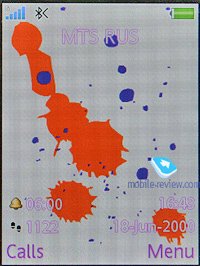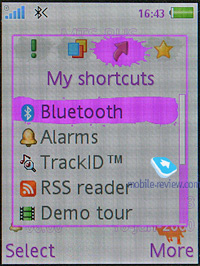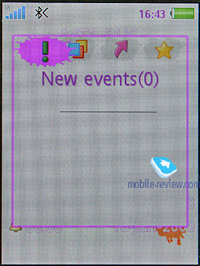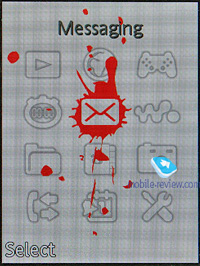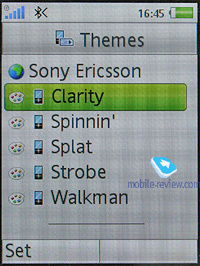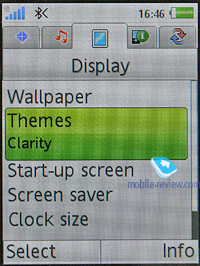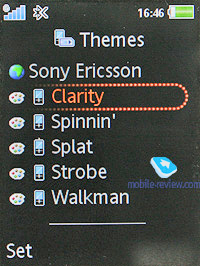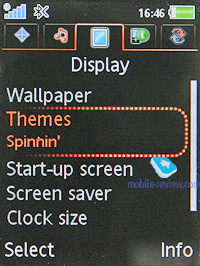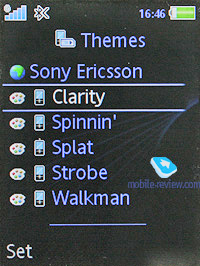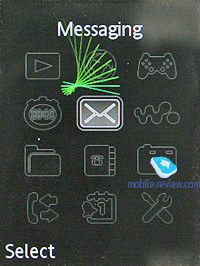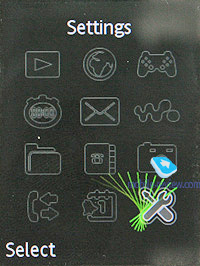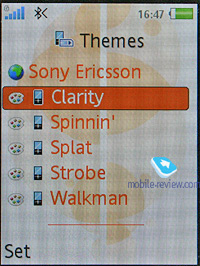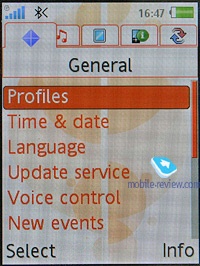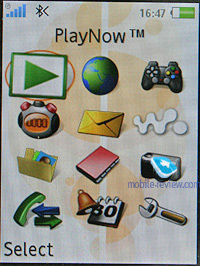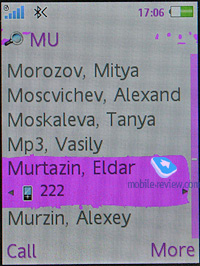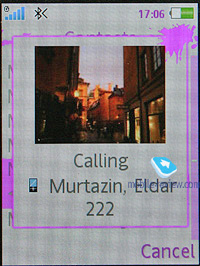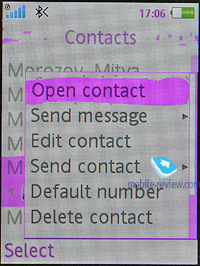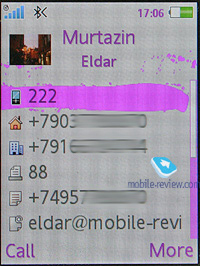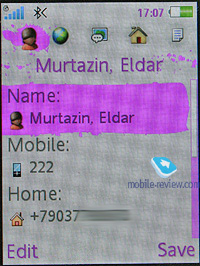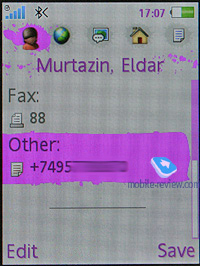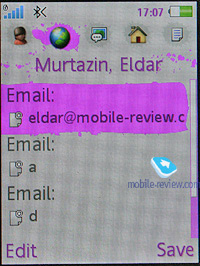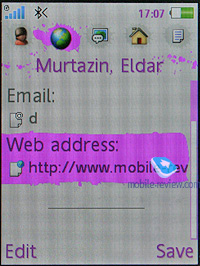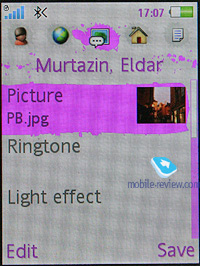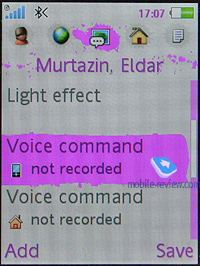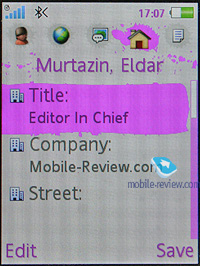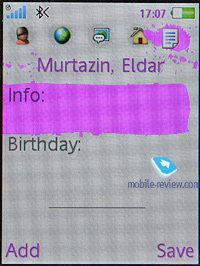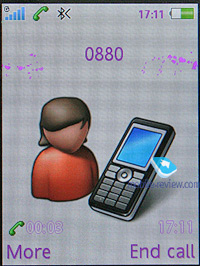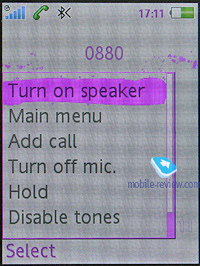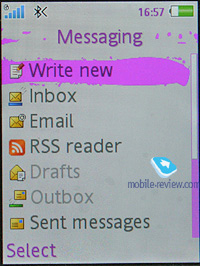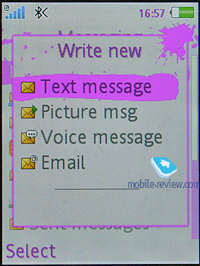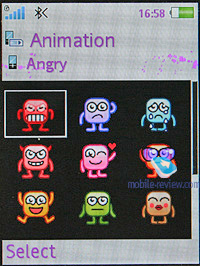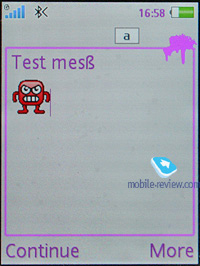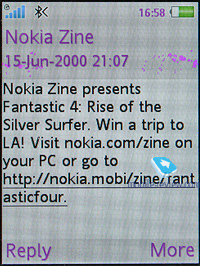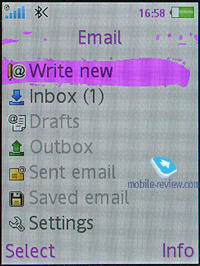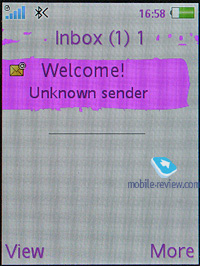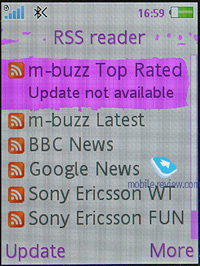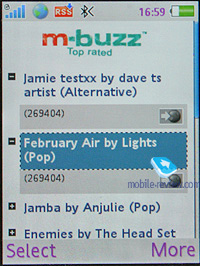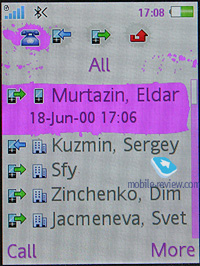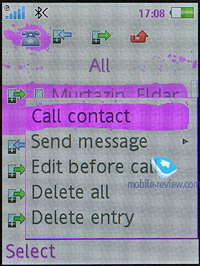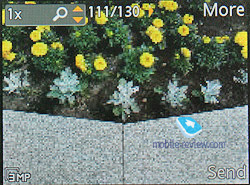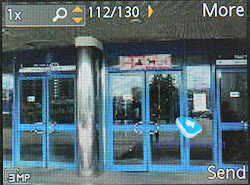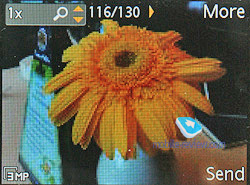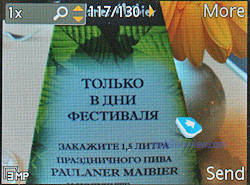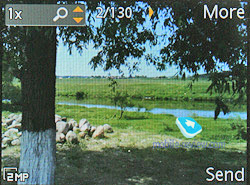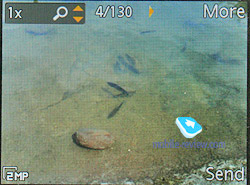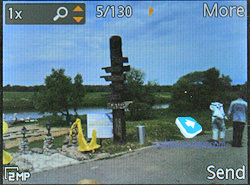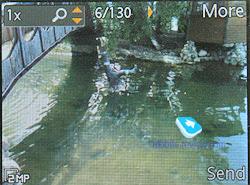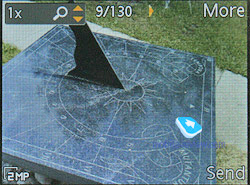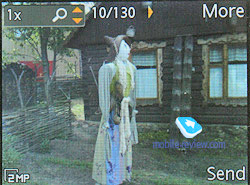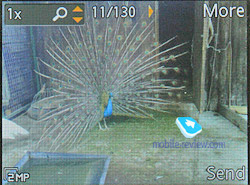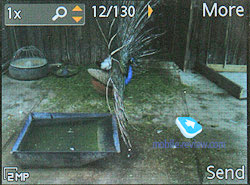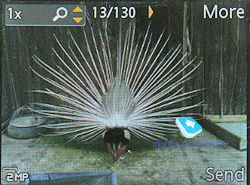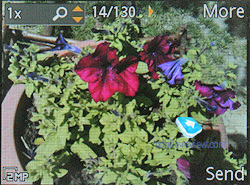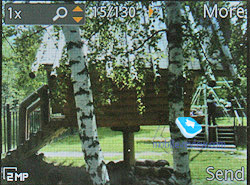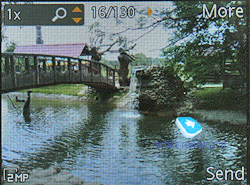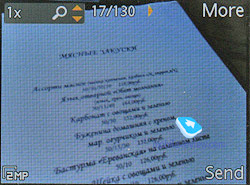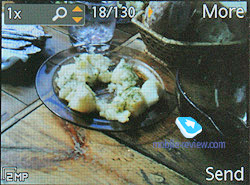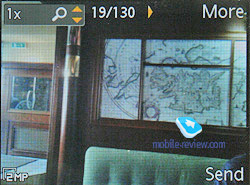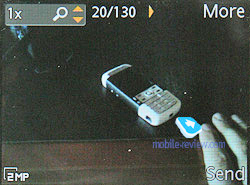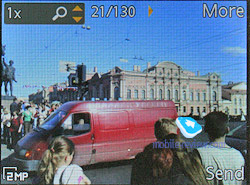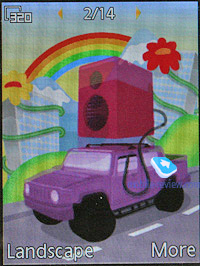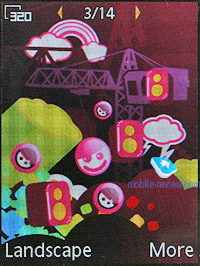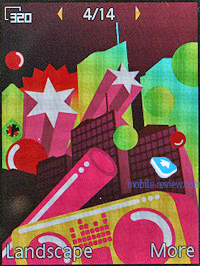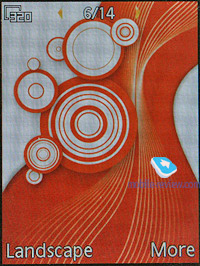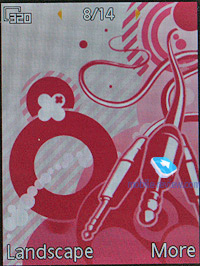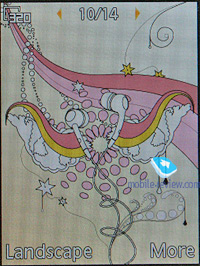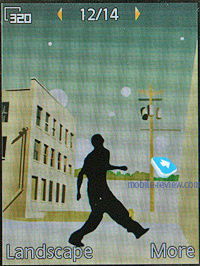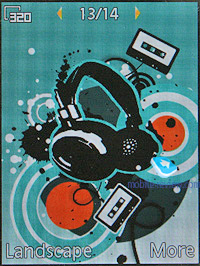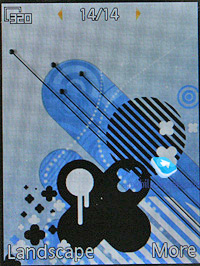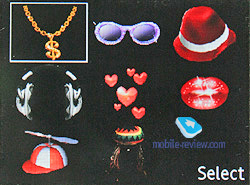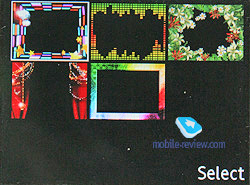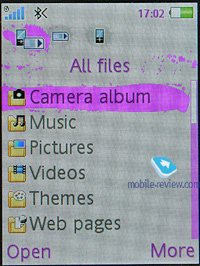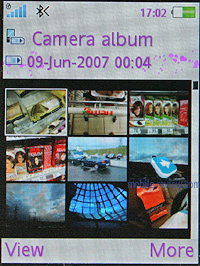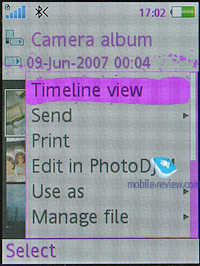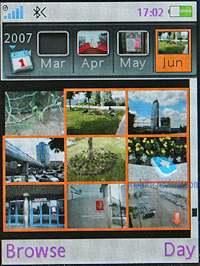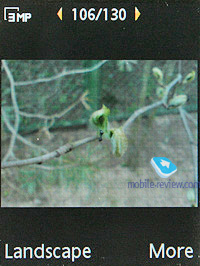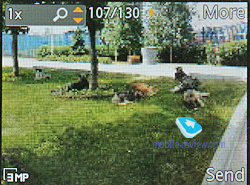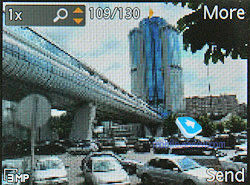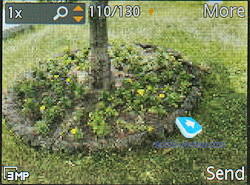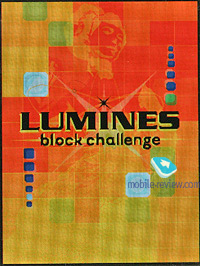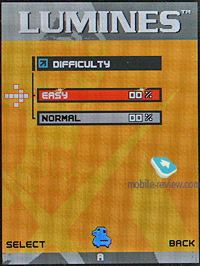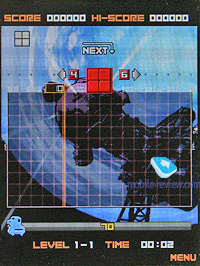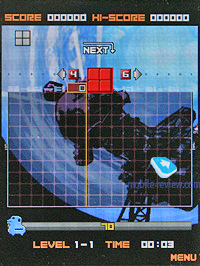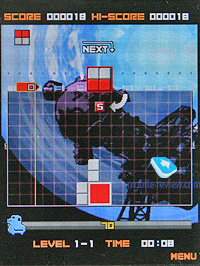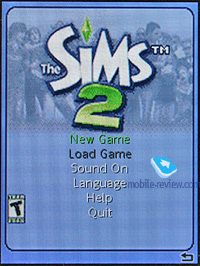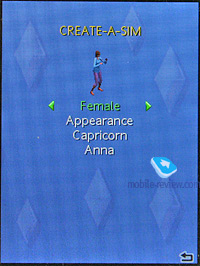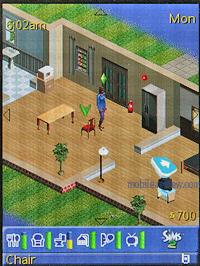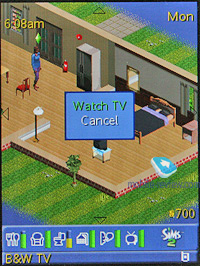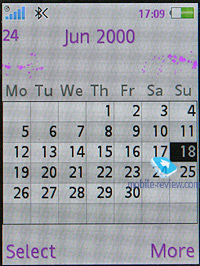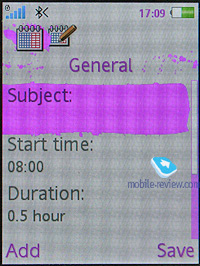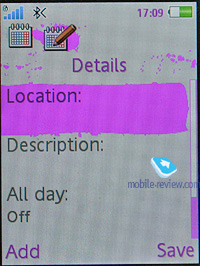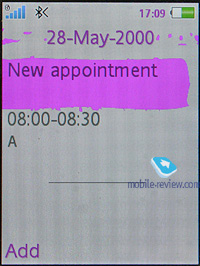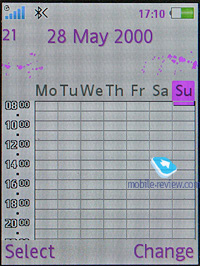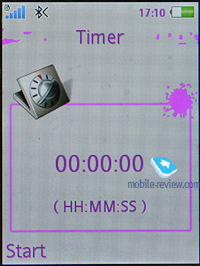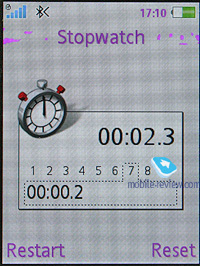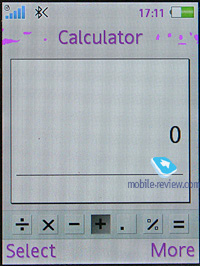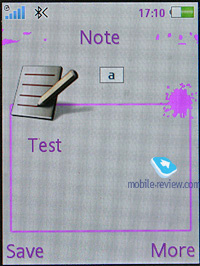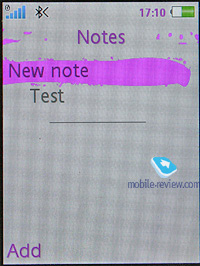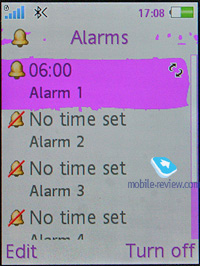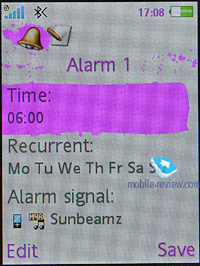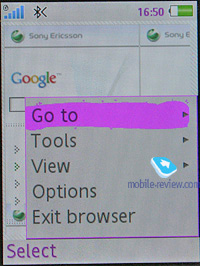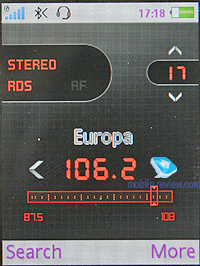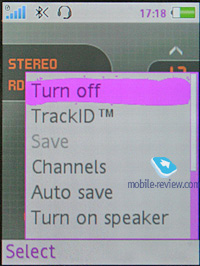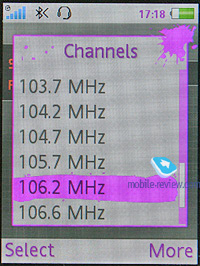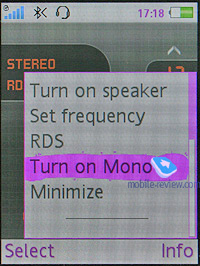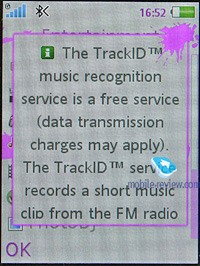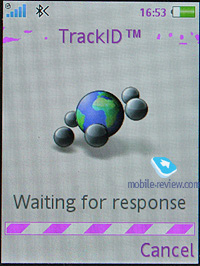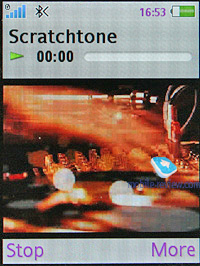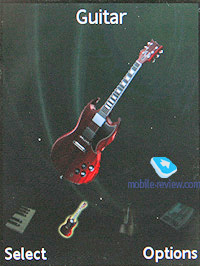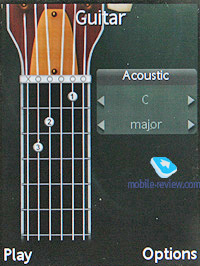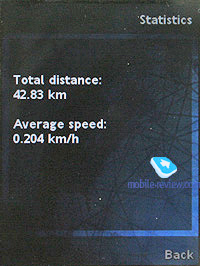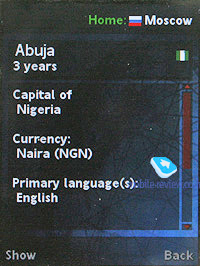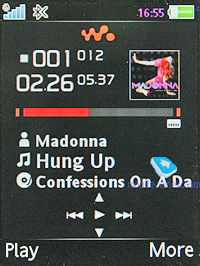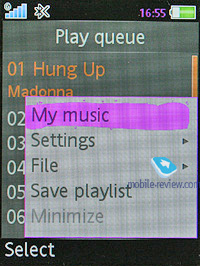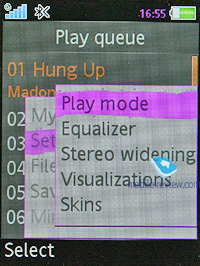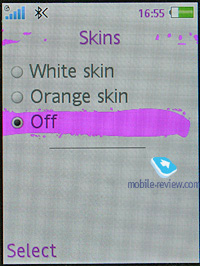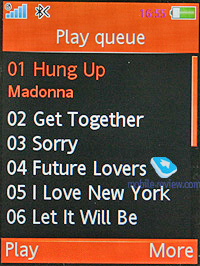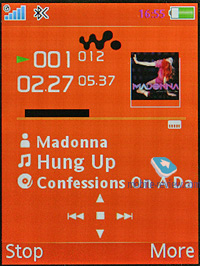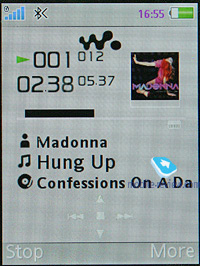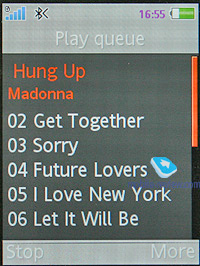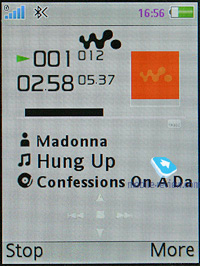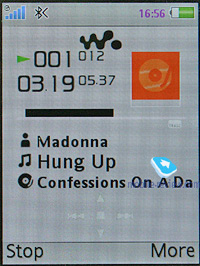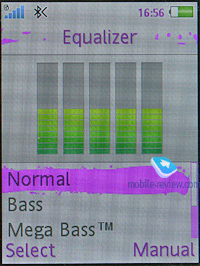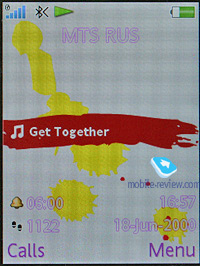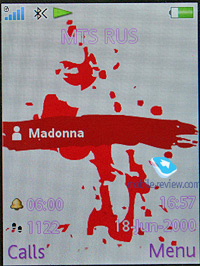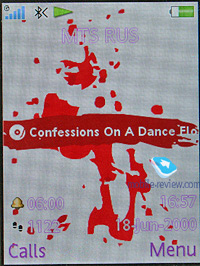|
|
Review of GSM-handset Sony Ericsson W580i
Live photos of Sony Ericsson W580i
Table of contents:
- Positioning in the company’s portfolio
- Design, size, controls
- Display
- Keypad
- Battery life
- Connectivity
- Memory, memory card
- Performance
- Motion sensor
- Light effects
- Camera
- Menu
- Impressions
Sales package:
- Handset
- Battery
- M2 512 Mb memory card
- User Guide
- Data cable
- Wired stereo-headset (HPM-70)
- Charger
Positioning in the company’s portfolio
While the Sony Ericsson W580i comes from the Walkman line-up, it caters for the younger audience, people leading active life-stile and music-aficionados addicted to communication. The model was initially planned as a youth-aimed offering, and the maker tried to avoid any sort of overlapping with the rest of its portfolio. And this is where it has led – on the one end is the Sony Ericsson S500i with a lighter price tag, diminished suite of features (lacks pedometer as well as a number of games and applications), but with emotional themes. And then, the range is topped by the Sony Ericsson W850i, matching the Sony Ericsson W580i shape-wise and belonging to the Walkman line too.

So it turns out that technically the model shares much with the Sony Ericsson W710i, and has roughly the same positioning and target demographic. At the same time it was the Sony Ericsson W580i whose release could shatter the subtle balance in the company’s portfolio, as the pricing policies would apparently overlap.
Let’s take a look at the functionality of these solutions so as to evaluate their potential.
Model |
Sony Ericsson W580i |
Sony Ericsson S500i |
Sony Ericsson W710i |
Sony Ericsson W850i |
Form-factor |
Slider |
Slider |
Clamshell |
Slider |
Size,weight (mm, grams) |
99x47x14, 94 |
99x47x14, 94 |
88x48x24.5, 100 |
98x47x21, 118 |
Display |
2 inches, 240x320, 262K, TFT |
2 inches, 240x320, 262K, TFT |
1.9 inches, 176x220, 262K, TFT |
2 inches, 240x320, 262K, TFT |
EDGE |
Yes |
Yes |
Yes |
No |
Walkman player version |
2.0 |
2.0 |
1.4 |
2.0 |
Pedometer, personal trainer |
Yes/Yes |
No |
Yes/No |
No |
TrackID |
Yes |
Yes |
Yes |
Yes |
Polyphony |
72 |
72 |
72 |
40 |
UMTS |
No |
No |
No |
Yes |
Built-in memory |
12 Mb |
12 Mb |
10 Mb |
16 Mb |
Infrared |
No |
No |
Yes |
Yes |
Battery |
Li-Pol, 900 mAh |
Li-Pol, 900 mAh |
Li-Pol, 900 mAh |
Li-Pol, 900 mAh |
Such resemblance in the specifications is not a fluke, the models are tightly connected and with the help of a handful of traits were able to position themselves differently, and the centerpiece was form-factor and pedometer. But now let’s look at these devices from another standpoint in order to assess the potential of the handset we are reviewing today.
Model |
Sony Ericsson W580i |
Sony Ericsson S500i |
Sony Ericsson W710i |
Sony Ericsson W850i |
Price upon release |
340 Euro |
275 Euro |
270 Euro |
400 Euro |
Price in June, 2007 |
- |
- |
220 Euro |
320 Euro |
Price shift, % |
- |
- |
26% |
20% |
Started shipping |
August, 2007 |
July, 2007 |
August, 2006 |
August, 2006 |
EOL |
July, 2008 |
July, 2008 |
July, 2007, out of production |
Èþëü 2007, out of production |
Life cycle time |
11 months |
11 months |
11 months |
11 months |
We have somewhat missed the Sony Ericsson Z710i, which was the pair to the Sony Ericsson W710i, and basically the Sony Ericsson S500i/W580i is pretty much the same duo. But the company’s strategy has undergone a subtle change, specifically the price segments have gone 45-60 Euro up. In other words, if a year ago the Sony Ericsson Z710i kicked in at the level of 220 Euro, the Sony Ericsson S500i starts shipping this year with the price tag of 275 Euro. It is not solely about new form-factor, this is a mere side-effect. The company is taking a number of products into higher price-brackets in leaps and bounds, making them premium-solutions (remember the Sony Ericsson T650). Nokia and Motorola have picked similar ways, unlike Samsung which has been sticking to it from the very beginning and now there is almost no room for improvement.
What’s the summary on the table above? If we are to extend it, then the Sony Ericsson W850i’s place will be readily taken by the Sony Ericsson W910i, and surprisingly its price curve starts at 450 Euro. So obviously the company is taking itself into the higher price-bracket.

It doesn’t take a rocket scientist to predict the price curve for the device reviewed, basing on the tables above. The price will keep falling down 5-6 percent quarterly, which will result in 250 Euro in the end of the model’s life cycle.


The Sony Ericsson W580i will face competition within the company’s range coming from the senior model – the Sony Ericsson W850i. If a pedometer is not that crucial to your, then going for the latter is a smart choice at the end of its life cycle, namely in August or September, 2007. Having strong understanding of this fact, the company is getting more space for the new products by knocking the older ones out of the market.
Back to the table of contents >>> Design, size, controls
The handset, as the company’s designers say, is modeled in urban style, which is another hint at the target demographic. The W580i comes in a choice of two colors - Style White and Urban Grey. Both have visual appeal, at that the white trim is by no means feminine and will perfectly fit men's hands, though the latter will make smaller share in sales.

The W580i measures up at 99x47x14 mm, weight 94 grams. The device is fairly diminutive to be carried in any desired way. Speaking of the characteristic features, we can't overlook the slop on the front, which extends the casing’s curve. In this sense the handset is quite remarkable and looks pretty quaint, especially the rear view


The matt spangled plastic found here is quite decent. The W580i’s spines are painted in black. Due to the bottom end’s curvy lines, the Fast Port has been moved to the right-hand side, where fits just fine, so plugging in a headset is a breeze. One the other hand, if some of you carry their handsets not in short pockets, but in jeans, like me, then you won’t get round the issue of disconnecting the headset when taking the W580i out of the pocket holding the wire.





The microphone sits on the bottom end, as well as the holes for a carrying strap. The flap-covered memory expansion slot is on the top, the sunken power button is also here (pressing it accidentally is next to impossible). On the left spine is the volume rocker.


The slider zips open and closed smoothly with its spring mechanism. Although there is no thumb rest, its role has been taken on by the protruding navigation button, nevertheless your finger will always feel like punching the display up.


Back to the table of contents >>> Display
The display shows up to 262 K colors at 240x320 pixel resolution (2 inches diagonal, TFT), which allows accommodating up to 8 text and 3 service lines for most applications; and when browsing web-pages, or handling e-mails or text messages, you can cram more lines into the display by decreasing the font size.

Similarly to other Sony Ericsson’s models, the W580i utilizes mirror layer that improves its readability while in the sun and allows its picture to stay crisp and visible. The display boasts enhanced image sharpness and contrast, thus when we put it up against the Samsung U600’s matrix, we spotted only marginally smaller diagonal, while the colors were more vibrant and saturated on the Sony Ericsson W580i.







Back to the table of contents >>> Keypad
The set of functional keys is conventional for the company, the Walkman button is on the front face, although it doesn’t act as a music key in contrast to the prior models (doesn’t start or stop playback), so it is good only for bringing the player’s interface up. The Activity Menu key is placed on the left and unlike the A2-running offerings, the W580i retains Back and C buttons (no support for Nokia UI). The Walkman-esque navigation key is fairly stiff, yet comfortable; however it can’t stand up to that of the in S500i, where the things are a tad more convenient.

The numeric keys are made of plastic and mounted in horizontal rows. The number pad is a cinch to use, so nothing we would complain about here. Serving decoration purposes are the insets between the buttons, reminiscent of nail heads, which look pretty quaint and appeal to most users, without provoking any negative feelings.


All buttons are lit in white, which is well-visible in various environments.
Back to the table of contents >>> Battery life
The back cover sits firmly in its slot, and is easy to open. Removing it reveals a 900 mAh Li-Pol battery. As the maker claims, with this the W580i provides up to 350 hours of standby and up to 9 hours of talk time. In conditions of Moscow networks the battery life averaged two and a half days on moderate load (up to 1 hour of calls, about 30 minutes of games and 20 minutes of browsing). Getting heavier on its features automatically means daily recharging sessions. And if you will cut your total call time to the very minimum, the battery will stay up and running for about 3-4, but that’s an improbable scenario. Within the European networks the device will last for at least twice as long in all modes thanks to better coverage. Continuous music playback drains the battery in 16 hours.


Back to the table of contents >>> Connectivity
USB
On USB-connection you are forced to pick connection type – specifically whether you will be accessing data stored on the memory card or just keep managing the phone or activate Print mode. For the first mode we mentioned above the handset goes off and you gain access to the contents of both the memory card and the phone internal memory. Despite the maker claiming it to be USB 2.0, data transfer speed doesn’t exceed 500 Kb/s. If you just want your W580i to turn into a modem, then pick the second option, when you will have a chance to play around with various USB settings for going online.
Bluetooth
The handset comes with EDR-enabled Bluetooth 2.0, the menu enables you to turn on enhanced power saving mode. There is also A2DP support, which allows employing wireless headsets with the W580i. The list of supported profiles:
- A2DP;
- Basic Imaging Profile;
- Basic Printing Profile;
- Dial-Up Networking Profile;
- File Transfer Profile;
- Generic Access Profile;
- Generic Object Exchange Profile;
- Handsfree Profile;
- Headset Profile;
- HID;
- JSR-82 Java API;
- Object Push Profile;
- Personal Area Network Profile;
- Serial Port Profile;
- Service Discovery Application Profile;
- Synchronization Profile;
- SyncML OBEX binding;
Back to the table of contents >>> Memory, memory card
The handset comes equipped with about 18 Mb of user-manageable memory, as well M2 512 Mb memory card. You can always swap cards on the go, as long as they don’t exceed 2 Gb in size.
Back to the table of contents >>> Performance
The W580i puts up typical numbers for the company’s latest generation of devices and is ahead of most models available on the market. Low screen resolution, relative to the senior models, has had a positive effect on its performance, the interface seems extremely speedy. There are no limits on JAR-file size, HEAP size – from 512 Kb to 1.5 Mb.
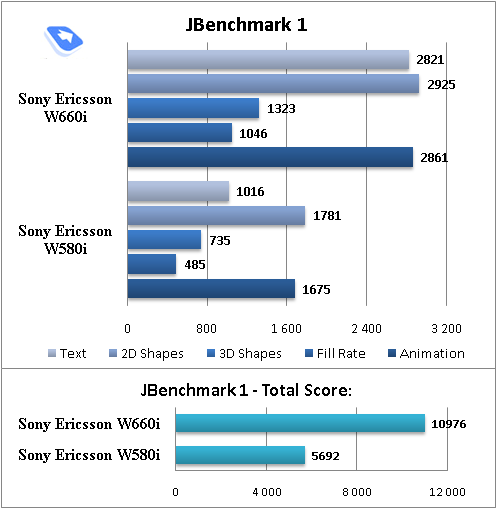
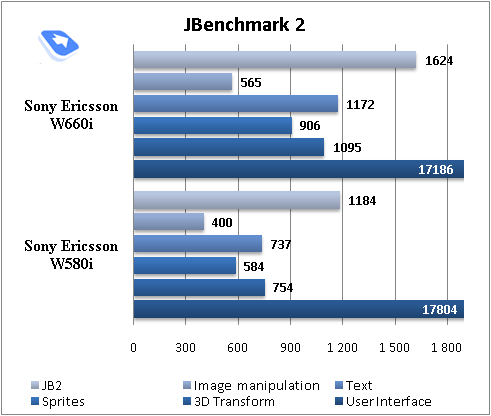

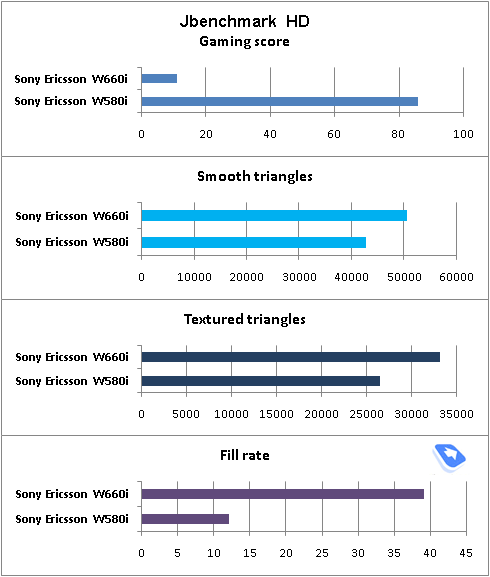
Back to the table of contents >>> Motion sensor
The company is looking to use motion sensors in order to tack various extra feature onto its products, for instance in the Sony Ericsson K850i the sensor tracks the handset’s position and automatically shifts display layout. Much like the Sony Ericsson W710i, here the maker has decided to focus chiefly on the sports-related application. The base version is almost completely identical to that found in the Sony Ericsson W710i.
The W580i has the following to offer: two modes (Walking and Running), adjustable values of distance, time, upper and lower bounds of speed. Personal data includes age, sex, weight, height – basically everything that is essential to evaluate amount of calories spent. While running or walking the screen reflects all information you can only dream of – elapsed time, covered distance, current speed, and user is also at liberty learn more on calories burnt, average lap time or just reset all acquired data and begin a new cycle. The settings seem to be enough for an ordinary man, although sportsmen aren’t likely to find something of great interest in them. Yet the most brilliant function is the ability to set up the measurements individually, this is the way it works: if you know how long is the distance you are going to run, you can adjust the settings minutely after covering it, so all posterior evaluations and data will be even more precise.
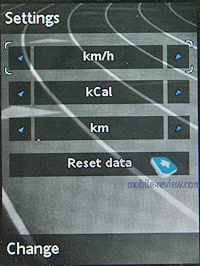
Curiously, the W580i keeps counting steps throughout the day (can be turned off) – while at the standby screen the display features respective numbers. At midnight all data on this gets reset automatically and it starts the whole thing all over again.
Speaking of interesting abilities, here you can save results in a text file that can be then sent to other devices or shared via e-mail.
The most significant change they have made is the personal trainer application that makes your work-outs a more interesting affair. It is an add-on to the default pedometer functionality, which analyzes all the data the latter collects. In fact you can check out statistics on your work-outs, total time, number of work-outs, calories burnt, distance traveled. The application automatically awards you various medals for some achievements, there is a great many of them, which kind of sets certain goals and thus makes work-outs more exciting. Diagrams, which provide easier-to-catch data layout, are also available.
As an additional feature there is some sort of a quiz, where you answer sports-related questions or just learn more about remarkable facts.
For now, this application is rivaled by similar Nokia’s training diaries, but those are tailored to work with GPS-enabled devices and drain more power while in work-out mode. As for this solution, it offers fairly good precision to analysis ratio.
And if you are really intending to have work-outs with your handset, then make note that there is no arm-band like that shipped with the Sony Ericsson W710i, also the headphones supplied are quite ordinary, non-sporty type. So these accessories will set you back some more money (as of today, there is no native arm-band to pick up).
The motion sensor is also used for turning on shuffle mode, this feature goes under the name of Shake Me, meaning that you simply need to shove the phone to make it jump to a random track, this is another feature for sportsmen.
Back to the table of contents >>> Light effects
Ever since the Sony Ericsson W850i the company has been into light effects, and the W580i represents another consistent step up in this direction. The phone’s side-plates retain LEDs that can generate various combinations of light effects and differ both in terms of color and rhythm. When the W580i is flicked open, all this looks more appealing, but these effects can be seen with the device zipped closed as well. The keys on the front fact swap backlighting in a similar fashion. Though you can’t pick or setup these effects, you can enjoy only those coming pre-installed with the handset. Nevertheless with 22 of them, there is quite a pool to select from, so no one will leave without an own theme. Plus you are enabled to bind up a personal light effect with a contact in your phonebook.

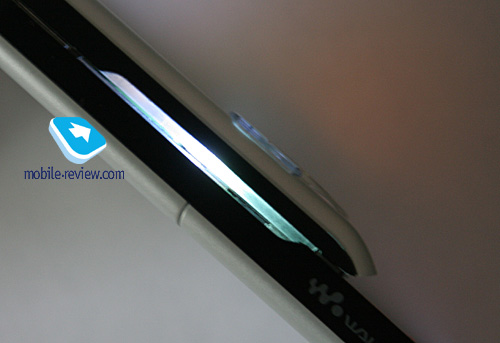

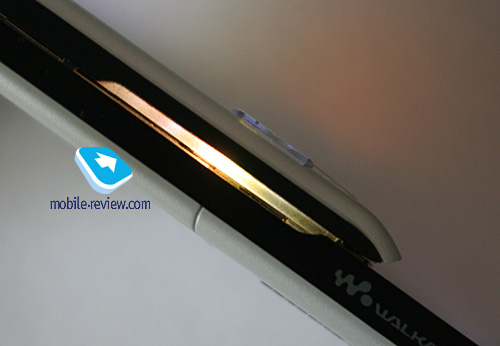
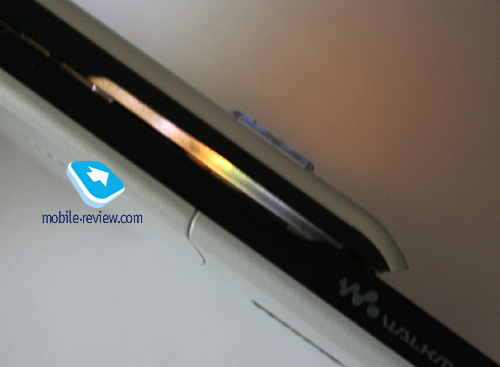
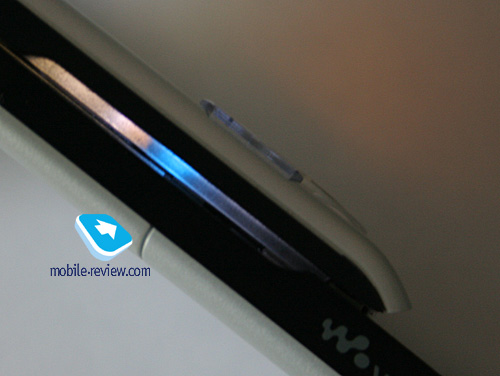

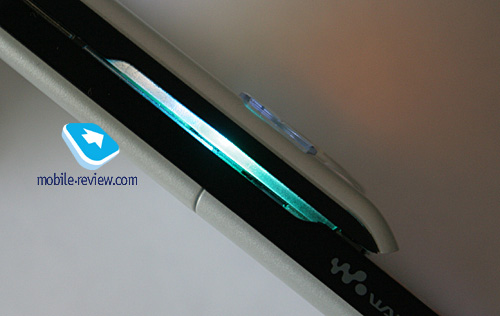

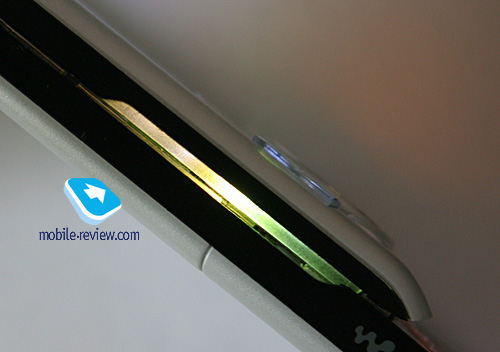
Back to the table of contents >>> Camera
The device is equipped with a 2 MP camera with a CMOS matrix without auto-focus. The device supports three possible resolutions - 1632x1224, 640x480, 160x120 pixels. Two types of data compression (Normal and Fine) are at your disposal. The majority of the sample photos are in the Fine quality. The photos differ in size almost two times depending on the resolution. Thus a photo in the Normal mode takes up about 300 KB while the Fine quality results in 500-600 KB. Saving a photo takes the same time not depending on chosen type and makes about 1-2 seconds, and that is quite speedy for such file size. When taking several photos one after another (not in the Burst mode but just successively) then you'll notice slight slowdowns (up to 3-4 seconds). My subjective feelings tell me the device buffer includes 2 Mb of memory.

The camera settings look in the following way:
- · Shutter sound. You can choose on of the three shutter sounds but not turn the sound off.
- · White balance. A possibility to choose between an auto-mode, Incandescent, Fluorescent, Daylight.
- · Effects. Several effects may be applied to the photos, these are Negative, Solarize, Sepia, Black & White.
- · Timer is activated for a certain time period for self shooting.
- · Night mode is for shooting in the dark. Noises raise on a photo, exposure time gets increased (you shouldn't move the device in order not to get a blurry photo).
- · Shooting mode. Normal mode, that takes ordinary photos. Multishot-mode (Burst 4) allows taking four photos in a series. Landscape is a very interesting mode that allows taking rather fetching photos; the market hasn’t seen anything similar to date yet. The last mode is taking photos with frames, photo resolution is decreased automatically.
The screen serves as a viewfinder while in the shooting mode. The picture moves very smoothly, details don’t get dropped out. Numeric keys help in switching between various functions and shooting parameters quickly that significantly fastens work.
 |
 |
| (+) maximize, 1600õ1200, JPEG |
(+) maximize, 1600õ1200, JPEG |
 |
 |
| (+) maximize, 1600õ1200, JPEG |
(+) maximize, 1600õ1200, JPEG |
 |
 |
| (+) maximize, 1600õ1200, JPEG |
(+) maximize, 1600õ1200, JPEG |
 |
 |
| (+) maximize, 1600õ1200, JPEG |
(+) maximize, 1600õ1200, JPEG |
 |
 |
| (+) maximize, 1600õ1200, JPEG |
(+) maximize, 1600õ1200, JPEG |
 |
 |
| (+) maximize, 1600õ1200, JPEG |
(+) maximize, 1600õ1200, JPEG |
 |
 |
| (+) maximize, 1600õ1200, JPEG |
(+) maximize, 1600õ1200, JPEG |
 |
 |
| (+) maximize, 1600õ1200, JPEG |
(+) maximize, 1600õ1200, JPEG |
 |
 |
| (+) maximize, 1600õ1200, JPEG |
(+) maximize, 1600õ1200, JPEG |
 |
 |
| (+) maximize, 1600õ1200, JPEG |
(+) maximize, 1600õ1200, JPEG |
Video may be recorded in two resolutions (176x144, 128x96), file format is 3GP. Clip duration may be limited (up to 10 seconds) or unlimited. The quality of the clips is below all criticism; so far this has been the weakest spot of all Sony Ericsson-branded devices.
Video sample 1 (3gp, 0.3 Mb)>>>
Video sample 2 (3gp, 0.1 Mb)>>>
Back to the table of contents >>> Menu
The main menu pops up before you as a grid consisting of 12 icons (one of the themes also features horizontally laid out menu). Shortcut number navigation is on the W880i’s spec sheet as well – you can assign shortcuts to most menu items, that the handset comes pre-installed with, whereas own applications or files can’t be set up for one-touch access.
Text input has remained on the same comfort level, so, pressing the "#" key brings out a list of the available languages and you can easily switch between them while typing.
Besides traditional vertically arranged sub-menus, the maker has provided subject-based horizontal tabs. It means that while viewing a list of the dialed numbers, one can see not only the dialed numbers but in the same time (by leaning the joystick horizontally) switch between missed and received call tabs. In the phone menu this kind of navigation is provided anywhere it's possible and it makes for much better usage experience. The menu ergonomics is quite high in this phone. I also have to note that such horizontal tabs appear in Phonebook, Settings and other menu items as well.
Activity Menu is standard Sony Ericsson fare. The first three tabs display various events, like missed calls, memos, messages – actually all this can be found in the first tab. One can disable Activity Menu for these events as well – in this case pop up windows, reminding of a certain event type will appear on the screen. The third tab features the shortcuts, which you should set up yourself. And the added fourth one contains links to the most frequently used applications and resources – and the top of this list is claimed by Google search.

The second tab is the most interesting, since it appears to be some kind of a task manager, featuring the list of all currently running applications. User is able to have up to eight Java-applications launched (in fact there are no definite caps) simultaneously and switch between them. This may come in handy, in case you use an ICQ-esque mobile client, which should be constantly online, and at the same time want to play a Java-game. Up to now counterparts of this solution by other manufacturers haven't been announced.
Themes, design components
Unlike the S500i this handset isn’t positioned as an emotional offering, yet it retains all the makings of one. That is, the handset comes pre-installed with 5 different themes, which are all flash-based and alter the main menu view, as well as its layout. These themes are very interesting, vibro-effects trigger when navigating through the menu, and some themes modify position of track information windows in standby. In a word, the W580i is decent in the sense of themes.
Another thing of note here is a couple of video-tones that come with the handset – in fact, these are quite simple tunes merged with straightforward graphics, which can be used as ring tones. So far none of the makers has offered any sort of this feature, although Nokia is coming this way as well, however it hasn’t rolled out pre-installed tones as yet.
Phonebook
Up to 1000 contacts with fully filled in fields can be stored in the phonebook, but number of phone numbers is limited to 2500. This means that despite the ability to assign up to 5 phone numbers to one contact, you cannot go over 2500 entries. This is enough even for the most active users, as only few have more than 500 entries in their phonebooks.
As mentioned above, several phone numbers can be submitted for one contact, as well as address, email, IM number, other contact information. In settings you can select the required fields, they will be available, meanwhile the useless ones will not be presented. Contacts can be sorted by fields, including name and surname, but only one input field. Unlike previous models, this time we have dynamics on - handset automatically sorts the list after changes.
It is possible to assign custom ring tone and photo to each contact. On incoming call the image and ring tone will be used. Date of birth field can be synchronized with Organizer, at that you will have a chance to set how many days prior to the event the handset should warn you.
When typing in information, you can scroll between tabs, in the first one you enter phone numbers, categorize them by types. On the whole the organization of this process reminds of Outlook, and it means comfort in the first place. Voice tags can be added for required phone numbers, names, there can be up to 40 of them. Voice dialing remained the way it was many months ago, it starts looking archaic with all these voice independent recognition software being implemented by the competitors.
The company still follows its traditional beliefs that SIM-card is used only in case of emergency, that’s why the only way to see its contents is to go into special option in the menu. SIM contacts are not displayed in the general list.
You can create a back-up copy of all entries in phonebook, which will be stored on the memory card, so that you will have the ability to restore them afterwards.
Contact Groups serve only for mass SMS sending, since it is impossible to bind custom ringtone or photo for Group.
Any video clip may be used as Caller ID for a contact in your phonebook. Also any contact many be assigned to one of the light effects.
Messaging
All tools used for managing messages are standard, there are some templates available and you can come up with some more of your own. Phone’s memory together with SIM-card is used for storing messages. Chat function is supported. On the whole everything is just like in any other phone from this company. Only emoticons icons have changed – now they look much more attractive.
The MMS implementation is as always great, you can literally create video clips, there are lots of settings and this is one of those things that give SE’s product a cutting edge over competitors.
E-Mail client can send and receive e-mails, all sorts of encodings are supported. The emails can be stored on memory card.
In email settings you can setup separate password for SMTP-accounts, this is very convenient. The settings are flexible, support for almost all encodings, and not only Unicode has been added. Attachments that are supported by the phone are presented as icons in an email’s body. The phone doesn’t recognize office files or PDF, but they can be stored in any directory. The limit for outgoing/incoming email size is set by operator. Emails with 6-7 Mb attachments can be sent without any hassles. The phone supports Push Mail standard. Naturally send & receive process is carried out in background mode.
RSS Feed. The settings for this item are really simple - you just specify the title for feed and its address. The phone will connect and download it without your assistance. You can update only one item, or the whole feed at once. Capabilities of built-in browser are used for displaying the feeds. Feeds may be updated on schedule
Call list
Up to 30 records can be stored in the general list, all with date and time. Icon that stands for call type (missed/received/dialed) is shown next to each entry. Besides this additional icon identifies if this phone number is present in the phone book or SIM-card. The list of missed calls can be viewed separately and stores up to 10 entries. In this menu you can also see the cost and length of all outgoing calls and last call. Navigating through the lists works with the help of tabs and this does save much time.
Entertainment
Photos, music files can be accessed from this menu. MusicDJ function is rather interesting, even though it is a niche solution and there is not much of a chance that this feature will be highly demanded. In the editor you can create ring tones and edit up to four bands.
Advanced version of MusicDJ is called VideoDJ, it allows editing not only music files, but also adding images and signs. The resulting file is recorded in .3GP file which can be sent by MMS or Email, or just transferred to another phone.
PhotoDJ has kept the name but had its inners completely revamped. The manufacturer has partly removed the shroud handing over the impending CyberShot projects, which will feature this editor by default. Now tell us, how often do you draw with your handset or create own pictures? The answer for most will be as clear as it only could be – never. At the same time getting rid of red-eyes effect, adjusting a shot’s brightness, contrast, sharpness, overlaying some effects, might well come in handy on certain occasions, but to do that you frequently have to wait the moment when you get photos uploaded to a PC. The new PhotoDJ looks to make performing these most basic actions as easy as it has never been before, enhance the handset with the ability to carry out these operations on the go. This is a really positive move.
Remote control – ability to control other devices via the phone’s Bluetooth connectivity. It is standard for all phones made by Sony Ericsson.
The sound can be recorded by Sound Recorder - it allows making clips that can be later used as ring tones. Phone calls can be recorded too, this is done from context menu, no time limits are set for the Sound Recorder.

Games – the handset comes with two games - Sims2, and also Lumines Block Challenge.
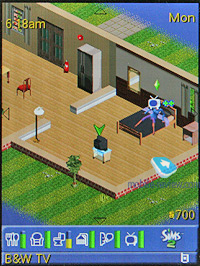
Organizer
Organizer keeps a lot of functions underneath. Let’s get Calendar out of the way first. There are three view modes embedded in the W580i’s calendar: weekly, monthly and daily. The last option displays the list of all events and memos, in two others you will see highlighted time or day. You can switch to required day and year, or month. So everything is pretty simple, just as the schedule input is. You get the ability to name the event, define the place where it will take place, set length and setup the reminder (before or right at the start of the event). Recurrent events support is also onboard. Types of reoccurrence: daily, monthly, yearly. Reminders work even if the phone is turned off as well, unless you disable this function.
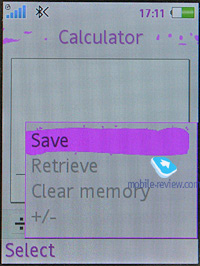
To do list in this phone is quite ascetic. There are only two types of events: phone call and reminder. On the other hand, this is really enough, simplicity has its own advantages.
The phone has full-fledged search, set up for calendar: you specify the search line (word or part of it) and after a while you will see all events that match this criteria. The function is quite speedy even if the organizer has more than 100 entries; fast switch to the event from the search window is supported.
Notes. The phone supports notes entry, though they are limited in length. The name of the note you see on the list will be first word entered. This is not always convenient since you will have to think of the first word that would tell you what the note is all about.
Alarm Clock. Now you have access to five alarm clocks, and each of them can be set up manually. They can work in definite week days. Besides the ring tone for alarm clock you can select small note and picture, they will be displayed when alarm clock goes on. Any music file can be assigned as the alarm tone.

Stopwatch/Countdown. Here everything is quite standard, although the same can be said of the stopwatch that has intermediate times function. The phone has special application for storing secret codes, which was a huge success in previous models, well, standard calculator is onboard too.
WAP
The browser owns a separate menu item, the version is 2.0, it supports secured connections which is quite important in case you are using electronic transactions. New wallpapers, themes and ring tones can be downloaded right away – all this is available at the original web-site.
Standard browser for Sony Ericsson phones is NetFront, which supports one-column web pages display and HTML. One of the best things about it, is the ability to create folders with files and bookmarks. The browser is considered to be one of the market’s best offerings, but limited phone resources do it no favors. On the whole those using Internet constantly should consider buying PDA or laptop, since full-fledged Internet access is not an ultimate must-have for this device type. At the same time RSS Feeds support is great, it allows using the phone for reading news, announcements and articles on the go in a convenient fashion.
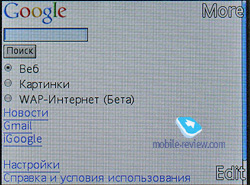
HTML pages that contain advanced formatting or exceed 500kb in their size will not be displayed. On the whole standard browser is all fine, but usage of Opera Mini is preferable, since it has got way more to offer.
Settings
This menu stores all settings related to the phone’s operation. In the stand by mode clock can be displayed at the bottom (on or off), you an also alter the font size, in case you select big letters it will be easy to see what time it is, but the font itself becomes a tad transparent. There isn’t anything to add, all the rest is standard.
File manager, memory volume
The user has 16-18 MB of available memory at his disposal, add empty M2 memory card to that too. Here all data (photos, videos, applications) can be stored. The remaining memory is occupied by preinstalled applications, which cannot be wiped. Part of memory is dedicated to phonebook, call lists, etc.
The phone has a basic file manager, with its help files can be sorted by various folders, custom directories can be created in phone’s memory, files can be moved there as well. With or without cable the phone can become a perfect storage, there are no problems with recording your own files, even if they cannot be opened by the phone.
Traditional file sorting includes the following options: date, type and size. The Image Gallery has new setting called Timeline, after you activate it you will see a bar on which months will be shown. And in lists you will see photos that were made during this or that month. You can make the list more detailed by pressing the same key twice, in that case you will see days instead of months. This is a good way to wander around in tons of images.
Video player
The manufacturer has singled out the player in an individual menu item for the purpose of emphasizing how different it is compared to the music player, and other makers’ offerings, where video and music players share one section. On the plus side is ability to playback QVGA-clips at 30 frames per second, progressive fast-forward feature, landscape mode switcher, auto-scaling of high resolutions down to the display’s size. And the last, but of course not the least, highlight on the list is possibility to get snaps of frames of the played back video, which are saved as pictures and can be used in whatever way you like afterwards.
Radio
The W580i has memory capable of storing up to 20 FM radio stations and the auto-tuning ability, as well as RDS feature onboard. The Radio application used here is no different from that found on the K750i quality-wise, meaning that it is mostly fine.
TrackID
Just like in Sony Ericsson W610i this handset has TrackID service (hidden in Entertainment menu), that’s when you can find out song’s title when listening to it on radio or recording it via microphone. Usually it takes around 3-4 seconds for length, later on file gets transferred to server GraceNote, where it interacts with huge data base. Unlike other models in the W580i you can not only get song title, but also buy it. Service is interesting due to momentum, instant and impulsive ability of buying that song you were looking for. It’s hard to say something else about this service. The attempt to boost popularity of this service is natural – the manufacturer has even granted it an own menu item.
Applications
The W580i retains two applications, which are Music Mate 2, a guide to various musical instruments. The other one is Walk around the globe that does the math and shows you the distance between your location and any other point on the globe, also it provides some info on countries. However we can only guess why this app has materialized.

Walkman player 2.0
The player comes in orange, but you can always pick white or black. While at the standby screen the player is always one click away – just push the orange Walkman button. Double pressing will minimize it back to the standby.
The handset locates all files and folders on the memory card, and then gets the necessary data from ID3-tags. Supported audio formats - MP3, AAC, AAC+, E-AAC+, WAV, WMA and m4a. There are no limitations on bit rates; you can also upload files with VBR. The company recommends using files with 192 Kbit/s bit rate.
In the music library, all saved tracks are classified by the following parameters:
Artists – the application displays general list of artists in alphabetical order, you can carry out a fast search here;
Albums – sorts by albums’ titles, search function is available as well;
Tracks –general list of all tracks, sorting is conducted by tracks’ titles or ID3 tags;
Genre – sorting, which uses various music styles, like Hip Hop, Jazz, Blues as criteria;
My playlists – these are playlists, made up by user, that can be created both on the device and on PC, while viewing contents of the flash memory in USB Mass Storage mode; the handset also locates then when updates the library.
Horizontal shifts between different tabs allow viewing not only album, but also artists list and songs. All navigation can be done with one or a few touches, and on each list you can use search by first letters.
In playback mode you can select whether corresponding image will be displayed (matching album) or Visualization (sort of screensaver that acts in tact with sound). Repeat of a single and all songs can be enabled, as well as Shuffle mode. Fast forward is progressive, if you hold the button the pitch will change.
There is also fast playback mode, when the W580i plays several seconds of every track and then jumps forward. The HPM-70 headphones are shipped with the handset; they are using Fast Port interface connector, meanwhile on the cord you will find a 3.5mm jack for typical earphones. The quality of the headphones is one of the best on the market. The W580i supports OMA DRM 2.0, which makes it compatible with almost all online shops that distribute music. The manufacturer has included Online channels menu item, where you can add different online shops. Depending on your operator and whether phone was sold by one or not, links in that menu may vary. New links can be downloaded with help of your operator, though that’s possible only in few countries including Russia. An important fact is that download service works in minimized mode, so you can order music without exiting player.
Back to the table of contents >>> Impressions
Despite the polyphony being 72-tone, the handset does not provide a breakthrough in sounding of mp3 tunes as compared to other Sony Ericsson branded phones. The loudspeaker is average volume-wise and has a great deal of basses in its sounding, so the call is easily heard even on the streets. The silent alert is of moderate power or even slightly higher than this, but even this admission isn’t an excuse for the cases when it proves too weak to be felt. The reception part is in line with other products by the company – in other words, it’s very fine.

The device starts shipping in August at the watermark of 340 Euro, and this way it will be a relatively steep solution, which won’t allow considering it a mass-market offering. At the same time, thinking of the Sony Ericsson W710i and the Sony Ericsson W850i sales, it is safe to say that the W580i will have an audience of its own. Some will fall for its pedometer, but they will make the minority, and others might like it as a quite cheap Sony Ericsson-branded slider.
For now, probably it would be a mistake to claim that the W580i had some sort of direct competition; Nokia is not into this segment, though the Samsung E740 looks like a potently offering. Motorola’s products are cheaper and positioned in a quite different manner. The Sony Ericsson W580i is fine, albeit it doesn’t have a tremendous spec sheet.
Back to the table of contents >>>
Eldar Murtazin (eldar@mobile-review.com)
Translated by Oleg Kononosov (oleg.kononosov@mobile-review.com)
Published — 09 July 2007
Have something to add?! Write us... eldar@mobile-review.com
|
News:
[ 31-07 16:21 ]Sir Jony Ive: Apple Isn't In It For The Money
[ 31-07 13:34 ]Video: Nokia Designer Interviews
[ 31-07 13:10 ]RIM To Layoff 3,000 More Employees
[ 30-07 20:59 ]Video: iPhone 5 Housing Shown Off
[ 30-07 19:12 ]Android Fortunes Decline In U.S.
[ 25-07 16:18 ]Why Apple Is Suing Samsung?
[ 25-07 15:53 ]A Few Choice Quotes About Apple ... By Samsung
[ 23-07 20:25 ]Russian iOS Hacker Calls It A Day
[ 23-07 17:40 ]Video: It's Still Not Out, But Galaxy Note 10.1 Gets An Ad
[ 19-07 19:10 ]Another Loss For Nokia: $1 Billion Down In Q2
[ 19-07 17:22 ]British Judge Orders Apple To Run Ads Saying Samsung Did Not Copy Them
[ 19-07 16:57 ]iPhone 5 To Feature Nano-SIM Cards
[ 18-07 14:20 ]What The iPad Could Have Looked Like ...
[ 18-07 13:25 ]App Store Hack Is Still Going Strong Despite Apple's Best Efforts
[ 13-07 12:34 ]Infographic: The (Hypothetical) Sale Of RIM
[ 13-07 11:10 ]Video: iPhone Hacker Makes In-App Purchases Free
[ 12-07 19:50 ]iPhone 5 Images Leak Again
[ 12-07 17:51 ]Android Takes 50%+ Of U.S. And Europe
[ 11-07 16:02 ]Apple Involved In 60% Of Patent Suits
[ 11-07 13:14 ]Video: Kindle Fire Gets A Jelly Bean
Subscribe
|
